Abstract
Low concentrations of propachlor (2-chloro-N-isopropylacetanilide) and alachlor [2-chloro-2',6'-diethyl-N-(methoxymethyl)acetanilide] were not mineralized, cycloate (S-ethyl-N-ethylthiocyclohexanecarbamate) was slowly or not mineralized, and aniline and cyclohexylamine were readily mineralized in sewage and lake water. Propachlor, alachlor, and cycloate were extensively metabolized, but the products were organic. Little conversion of propachlor and alachlor was evident in sterilized sewage or lake water. The cometabolism of propachlor was essentially linear with time in lake water and was well fit by zero-order kinetics in short periods and by first-order kinetics in longer periods in sewage. The rate of cometabolism in sewage was directly proportional to propachlor concentration at levels from 63 pg/ml to more than 100 ng/ml. Glucose but not aniline increased the yield of products formed during propachlor cometabolism in sewage. No microorganism able to use propachlor as a sole source of carbon and energy was isolated, but bacteria isolated from sewage and lake water metabolized this chemical. During the metabolism of this herbicide by two of the bacteria, none of the carbon was assimilated. Our data indicate that cometabolism of these pesticides takes place at concentrations of synthetic compounds that commonly occur in natural waters.
Full text
PDF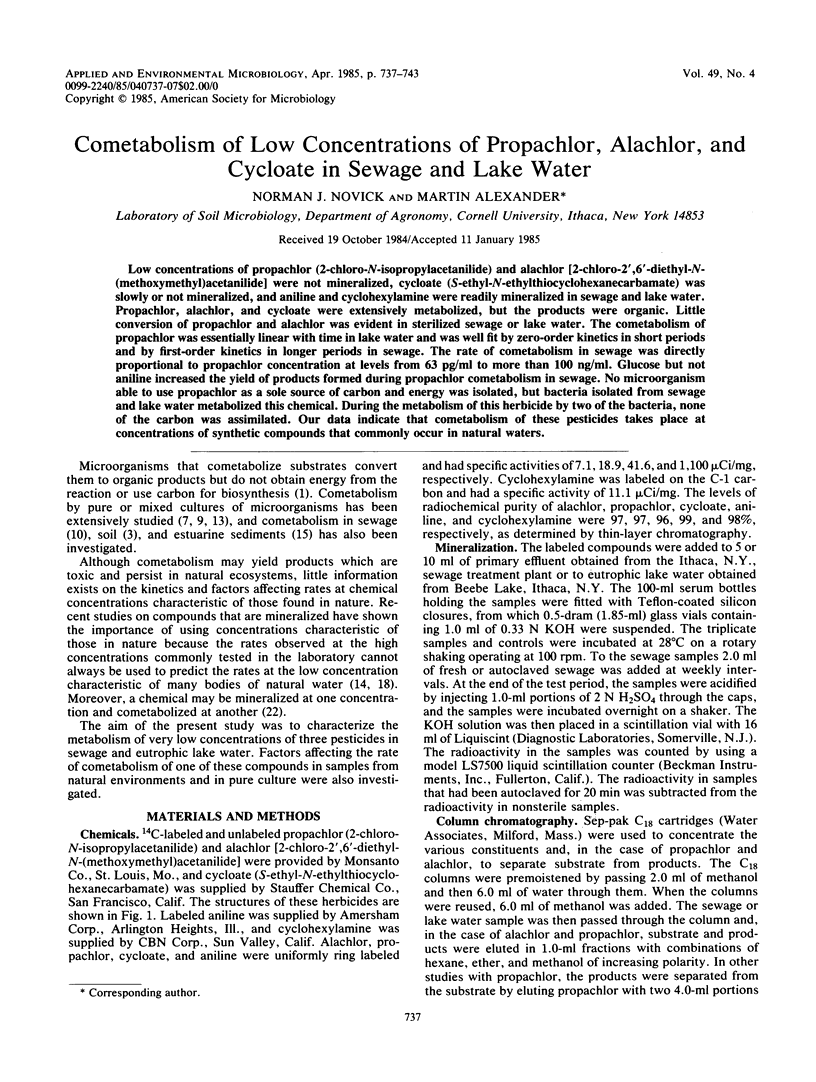
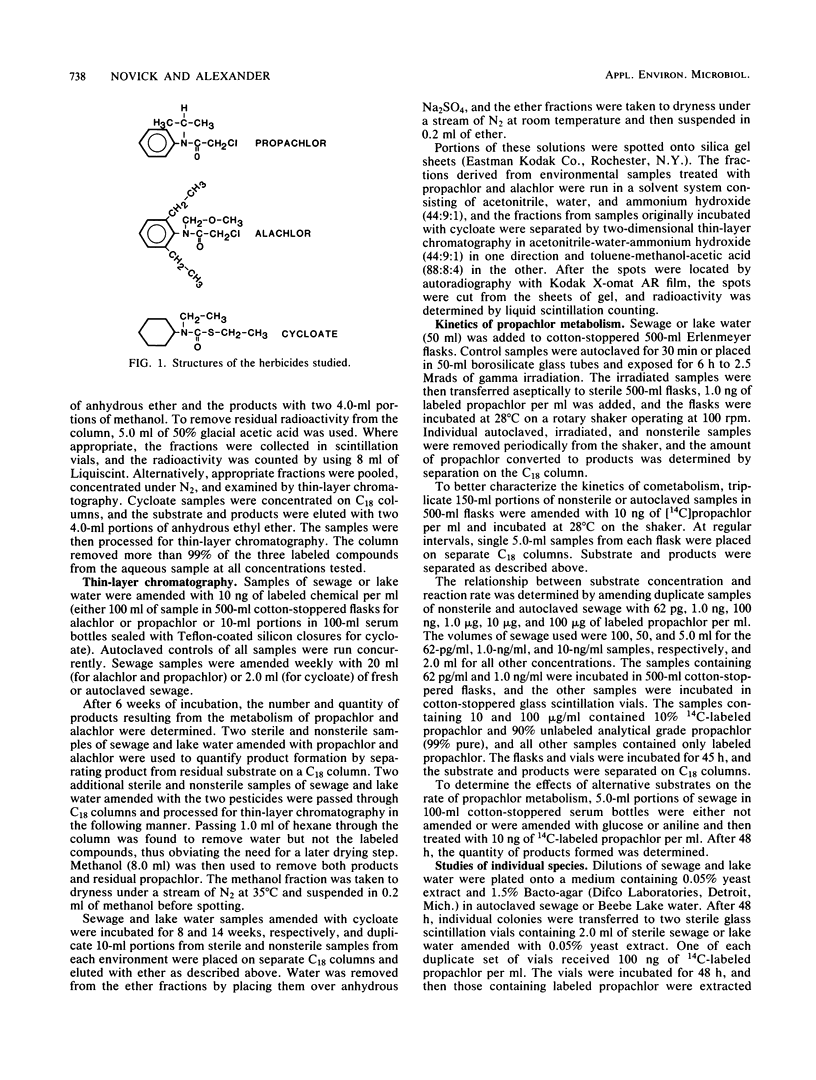
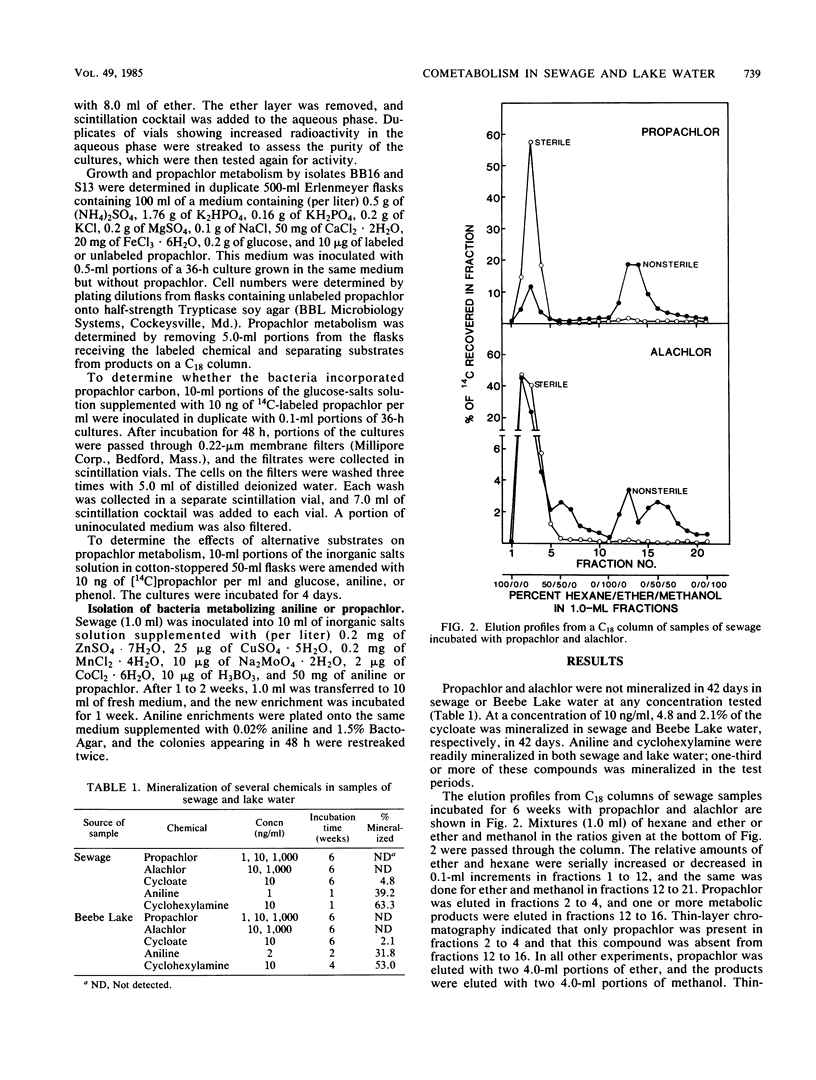
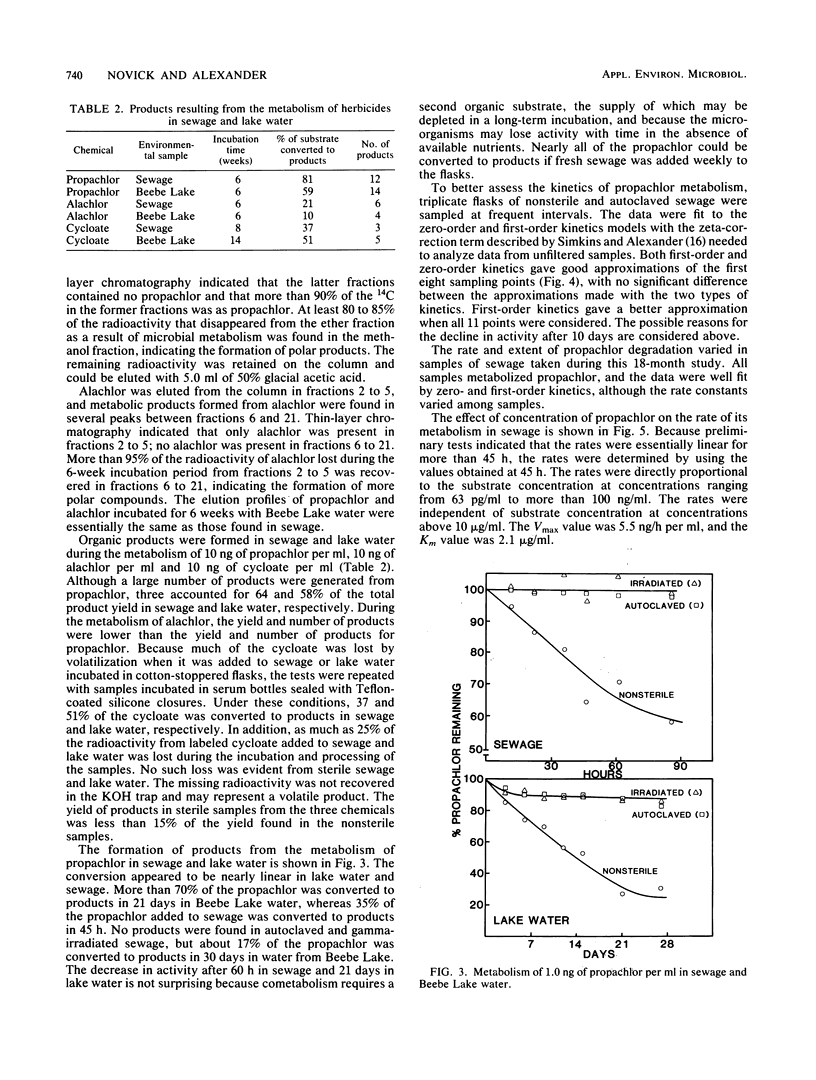
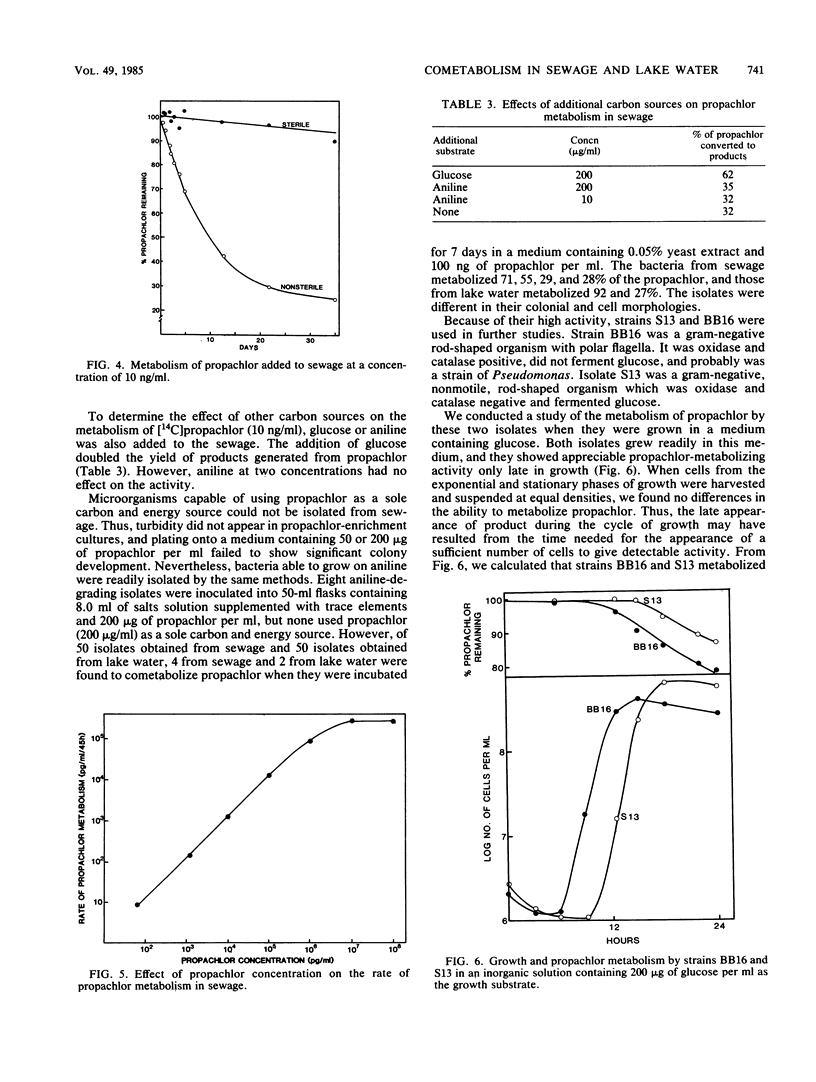
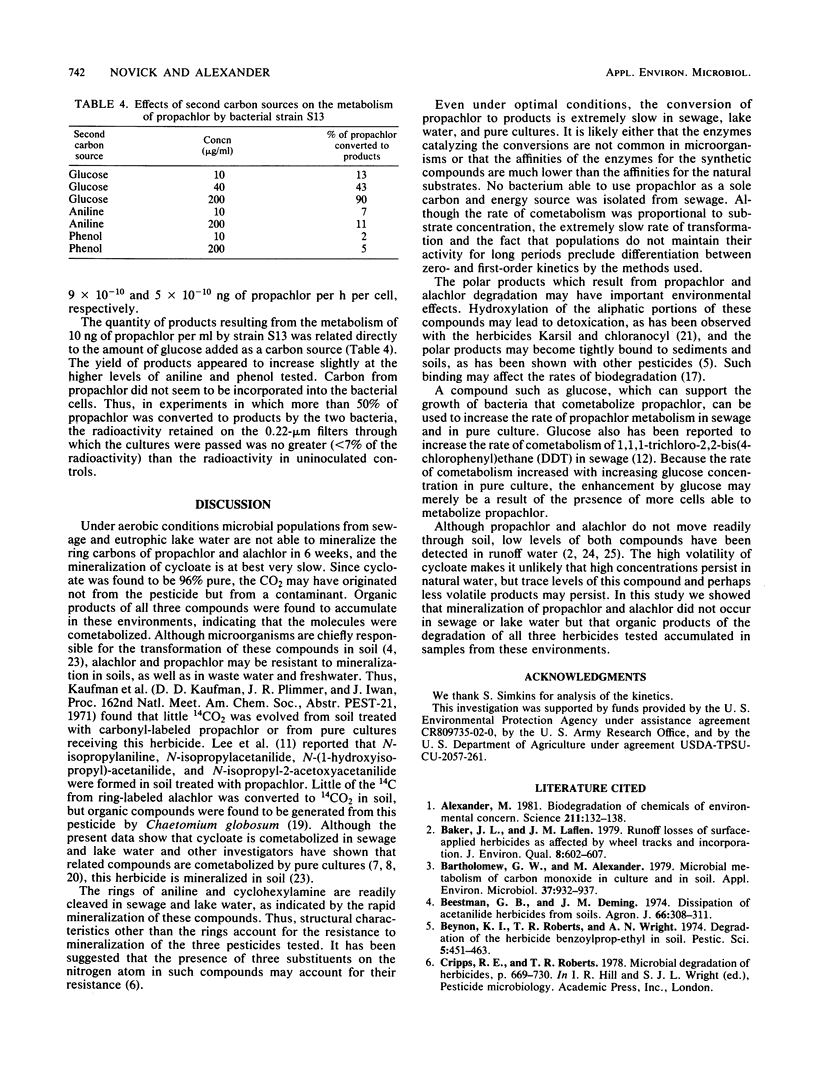

Selected References
These references are in PubMed. This may not be the complete list of references from this article.
- Alexander M. Biodegradation of chemicals of environmental concern. Science. 1981 Jan 9;211(4478):132–138. doi: 10.1126/science.7444456. [DOI] [PubMed] [Google Scholar]
- Bartholomew G. W., Alexander M. Microbial metabolism of carbon monoxide in culture and in soil. Appl Environ Microbiol. 1979 May;37(5):932–937. doi: 10.1128/aem.37.5.932-937.1979. [DOI] [PMC free article] [PubMed] [Google Scholar]
- DAVIS J. B., RAYMOND R. L. Oxidation of alkyl-substituted cyclic hydrocarbons by a Nocardia during growth on n-alkanes. Appl Microbiol. 1961 Sep;9:383–388. doi: 10.1128/am.9.5.383-388.1961. [DOI] [PMC free article] [PubMed] [Google Scholar]
- Horvath R. S. Cometabolism of the herbicide 2,3,6-trichlorobenzoate. J Agric Food Chem. 1971 Mar-Apr;19(2):291–293. doi: 10.1021/jf60174a020. [DOI] [PubMed] [Google Scholar]
- Jacobson S. N., O'mara N. L., Alexander M. Evidence for cometabolism in sewage. Appl Environ Microbiol. 1980 Nov;40(5):917–921. doi: 10.1128/aem.40.5.917-921.1980. [DOI] [PMC free article] [PubMed] [Google Scholar]
- Pfaender F. K., Alexander M. Effect of nutrient additions on the apparent cometabolism of DDT. J Agric Food Chem. 1973 May-Jun;21(3):397–399. doi: 10.1021/jf60187a046. [DOI] [PubMed] [Google Scholar]
- Rubin H. E., Subba-Rao R. V., Alexander M. Rates of mineralization of trace concentrations of aromatic compounds in lake water and sewage samples. Appl Environ Microbiol. 1982 May;43(5):1133–1138. doi: 10.1128/aem.43.5.1133-1138.1982. [DOI] [PMC free article] [PubMed] [Google Scholar]
- Shiaris M. P., Cooney J. J. Replica plating method for estimating phenanthrene-utilizing and phenanthrene-cometabolizing microorganisms. Appl Environ Microbiol. 1983 Feb;45(2):706–710. doi: 10.1128/aem.45.2.706-710.1983. [DOI] [PMC free article] [PubMed] [Google Scholar]
- Simkins S., Alexander M. Models for mineralization kinetics with the variables of substrate concentration and population density. Appl Environ Microbiol. 1984 Jun;47(6):1299–1306. doi: 10.1128/aem.47.6.1299-1306.1984. [DOI] [PMC free article] [PubMed] [Google Scholar]
- Subba-Rao R. V., Alexander M. Effect of sorption on mineralization of low concentrations of aromatic compounds in lake water samples. Appl Environ Microbiol. 1982 Sep;44(3):659–668. doi: 10.1128/aem.44.3.659-668.1982. [DOI] [PMC free article] [PubMed] [Google Scholar]
- Subba-Rao R. V., Rubin H. E., Alexander M. Kinetics and extent of mineralization of organic chemicals at trace levels in freshwater and sewage. Appl Environ Microbiol. 1982 May;43(5):1139–1150. doi: 10.1128/aem.43.5.1139-1150.1982. [DOI] [PMC free article] [PubMed] [Google Scholar]
- Tiedje J. M., Hagedorn M. J. Degradation of alachlor by a soil fungus, Chaetomium globosum. J Agric Food Chem. 1975 Jan-Feb;23(1):77–81. doi: 10.1021/jf60197a029. [DOI] [PubMed] [Google Scholar]
- Wallnöfer P. R., Safe S., Hutzinger O. Microbial hydroxylation of the herbicide N-(3,4-dichlorophenyl)methacrylamide (dicryl). J Agric Food Chem. 1973 May-Jun;21(3):502–504. doi: 10.1021/jf60187a047. [DOI] [PubMed] [Google Scholar]
- Wang Y. S., Subba-Rao R. V., Alexander M. Effect of substrate concentration and organic and inorganic compounds on the occurrence and rate of mineralization and cometabolism. Appl Environ Microbiol. 1984 Jun;47(6):1195–1200. doi: 10.1128/aem.47.6.1195-1200.1984. [DOI] [PMC free article] [PubMed] [Google Scholar]
- de Klerk H., van der Linden A. C. Bacterial degradation of cyclohexane. Participation of a co-oxidation reaction. Antonie Van Leeuwenhoek. 1974;40(1):7–15. doi: 10.1007/BF00394548. [DOI] [PubMed] [Google Scholar]
- v Ravenswaay Claasen J. C., van der LINDEN A. C. Substrate specificity of the paraffin hydroxylase of Pseudomonas aeruginosa. Antonie Van Leeuwenhoek. 1971;37(3):339–352. doi: 10.1007/BF02218504. [DOI] [PubMed] [Google Scholar]


